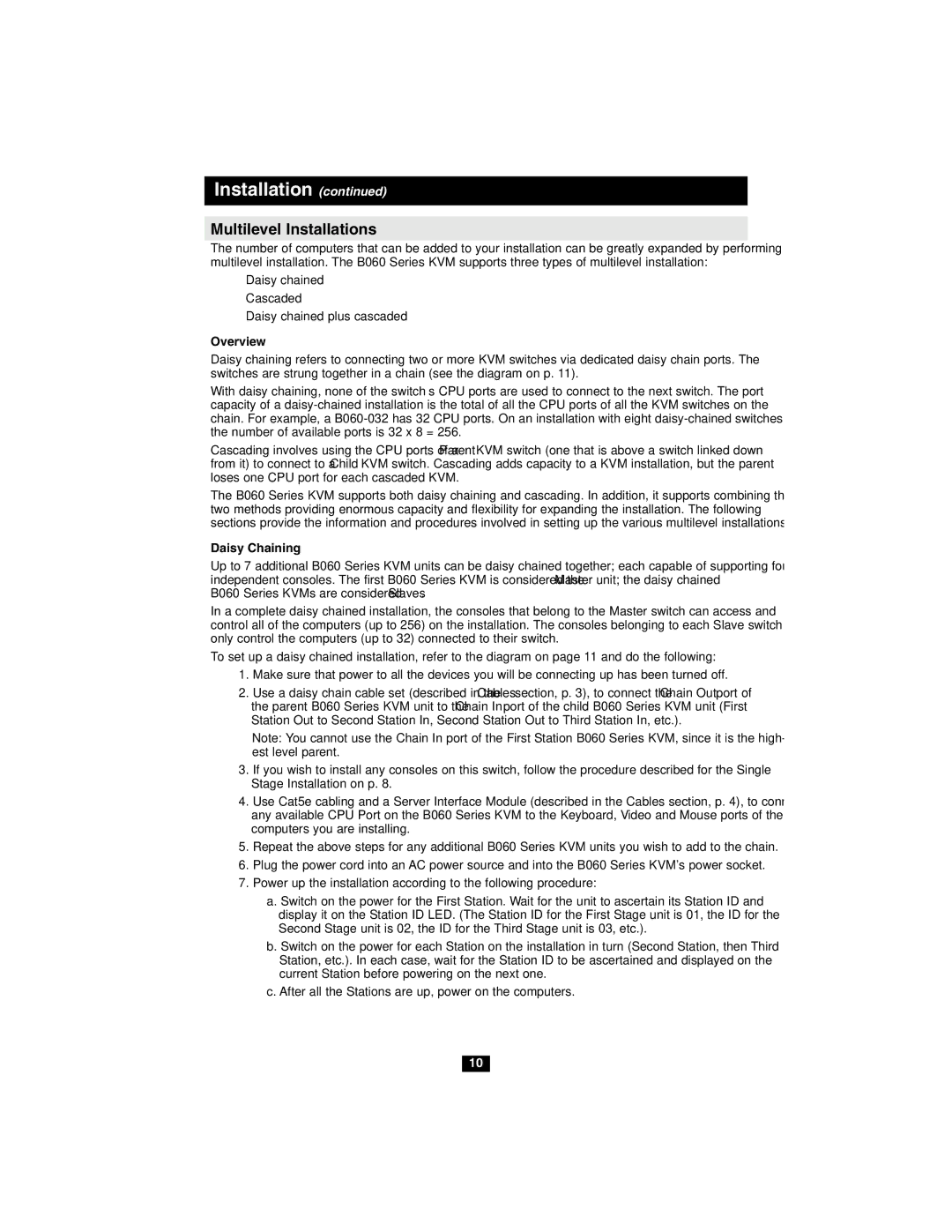
Installation (continued)
Multilevel Installations
The number of computers that can be added to your installation can be greatly expanded by performing a multilevel installation. The B060 Series KVM supports three types of multilevel installation:
•Daisy chained
•Cascaded
•Daisy chained plus cascaded
Overview
Daisy chaining refers to connecting two or more KVM switches via dedicated daisy chain ports. The switches are strung together in a chain (see the diagram on p. 11).
With daisy chaining, none of the switch’s CPU ports are used to connect to the next switch. The port capacity of a
Cascading involves using the CPU ports of a Parent KVM switch (one that is above a switch linked down from it) to connect to a Child KVM switch. Cascading adds capacity to a KVM installation, but the parent loses one CPU port for each cascaded KVM.
The B060 Series KVM supports both daisy chaining and cascading. In addition, it supports combining the two
Daisy Chaining
Up to 7 additional B060 Series KVM units can be daisy chained together; each capable of supporting four independent consoles. The first B060 Series KVM is considered the Master unit; the daisy chained B060 Series KVMs are considered Slaves.
In a complete daisy chained installation, the consoles that belong to the Master switch can access and control all of the computers (up to 256) on the installation. The consoles belonging to each Slave switch only control the computers (up to 32) connected to their switch.
To set up a daisy chained installation, refer to the diagram on page 11 and do the following:
1.Make sure that power to all the devices you will be connecting up has been turned off.
2.Use a daisy chain cable set (described in the Cables section, p. 3), to connect the Chain Out port of the parent B060 Series KVM unit to the Chain In port of the child B060 Series KVM unit (First Station Out to Second Station In, Second Station Out to Third Station In, etc.).
Note: You cannot use the Chain In port of the First Station B060 Series KVM, since it is the high- est level parent.
3.If you wish to install any consoles on this switch, follow the procedure described for the Single Stage Installation on p. 8.
4.Use Cat5e cabling and a Server Interface Module (described in the Cables section, p. 4), to connect any available CPU Port on the B060 Series KVM to the Keyboard, Video and Mouse ports of the computers you are installing.
5.Repeat the above steps for any additional B060 Series KVM units you wish to add to the chain.
6.Plug the power cord into an AC power source and into the B060 Series KVM's power socket.
7.Power up the installation according to the following procedure:
a.Switch on the power for the First Station. Wait for the unit to ascertain its Station ID and display it on the Station ID LED. (The Station ID for the First Stage unit is 01, the ID for the Second Stage unit is 02, the ID for the Third Stage unit is 03, etc.).
b.Switch on the power for each Station on the installation in turn (Second Station, then Third Station, etc.). In each case, wait for the Station ID to be ascertained and displayed on the current Station before powering on the next one.
c.After all the Stations are up, power on the computers.
10
